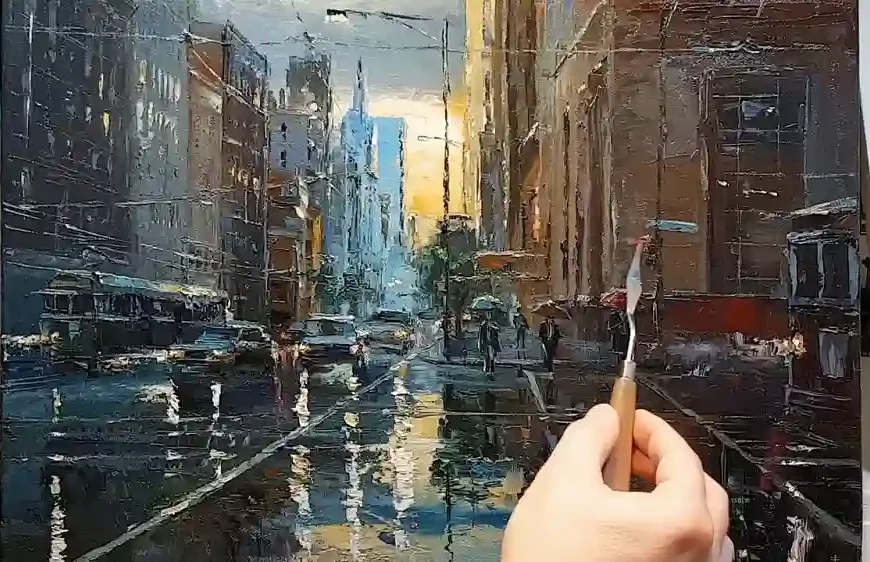Oil painting is not just about applying colors to a canvas; it’s about crafting a harmonious visual experience that resonates with the viewer. Central to this is the art of composition, the arrangement of elements within the painting. A well-balanced composition in oil art ensures that the viewer’s eye is guided, emotions are conveyed, and the artwork communicates its intended message. In this article, we will explore the principles of composition in oil painting and how artists can create harmony in their artworks.
Understanding Composition in Oil Art
Composition in oil painting refers to how the various elements within the artwork are arranged to create a visually pleasing and meaningful whole. A well-composed painting draws the viewer in, keeps their attention, and leaves a lasting impression. Here are some key principles of composition:
- Balance: Balance is one of the fundamental principles of composition. It involves distributing visual elements in a way that creates equilibrium in the artwork. There are two types of balance:
- Symmetrical Balance: In symmetrical balance, elements are evenly distributed on both sides of the central axis, creating a sense of stability and formality.
- Asymmetrical Balance: Asymmetrical balance achieves equilibrium through uneven distribution, with different elements on each side of the central axis. It often creates a dynamic and visually engaging composition.
- Focal Point: Every composition should have a focal point, a specific area or element that draws the viewer’s attention. The focal point is where the most critical details or the main subject of the painting resides.
- Rule of Thirds: The rule of thirds divides the canvas into nine equal parts using two horizontal and two vertical lines. Placing important elements along these lines or at their intersections can create a visually pleasing composition.
- Contrast: Contrast involves creating visual interest by placing elements that differ significantly in size, color, shape, or value near each other. Contrast can guide the viewer’s eye and create drama within the painting.
- Movement: Movement in composition directs the viewer’s eye through the artwork, leading them from one element to another. Artists can use lines, shapes, or implied movement to achieve this.
- Unity: Unity ensures that all elements in the composition work together harmoniously to convey a cohesive message or evoke a specific emotion. It creates a sense of completeness in the artwork.
- Repetition and Pattern: The use of repetition and pattern can add rhythm and consistency to a composition, creating visual interest and reinforcing the overall design.
Creating Harmony in Oil Art Composition
Now that we’ve explored the principles of composition, let’s discuss how artists can apply these principles to create harmony in their oil paintings:
- Plan Your Composition: Before starting a painting, spend time planning your composition. Consider the subject, the focal point, and the overall mood you want to convey. Sketch out different layouts and experiment with arrangements.
- Balance Elements: Whether you choose symmetrical or asymmetrical balance, ensure that the elements in your composition are distributed in a way that feels visually satisfying. Avoid overcrowding or leaving empty spaces unless it’s intentional for artistic effect.
- Emphasize the Focal Point: Make sure your focal point is prominent and easily identifiable. Use contrast, color, or detail to draw attention to this area. The focal point should be the most significant element in the painting.
- Use the Rule of Thirds: Consider applying the rule of thirds to your composition. Place key elements along the imaginary gridlines or intersections to create a balanced and visually appealing layout.
- Employ Contrast: Experiment with contrast to add depth and visual interest. Use differences in value (light and dark), color temperature, or size to create contrast between elements.
- Create Movement: Establish a visual flow within your composition. Use lines, shapes, or implied movement to guide the viewer’s eye through the artwork. Think about how the viewer’s gaze should travel within the painting.
- Seek Unity: Ensure that all elements in your composition contribute to a unified message or emotion. Elements should work together to reinforce the overall theme or idea of the painting.
- Consider Repetition and Pattern: Incorporate repetition or pattern where appropriate to create rhythm and consistency in your composition. This can be particularly effective in artworks featuring multiple similar elements.
Challenges and Considerations
Creating a harmonious composition in oil art is a skill that develops with practice, but there are some challenges to be aware of:
- Overcomplication: Avoid overcrowding your composition with too many elements or details. Sometimes, simplicity can be more powerful.
- Finding Balance: Achieving balance in an asymmetrical composition can be tricky. It requires careful consideration and experimentation.
- Maintaining Interest: While creating unity is essential, be cautious not to make the composition too predictable or repetitive, as this can lead to viewer disinterest.
- Subject Versus Composition: Striking a balance between portraying your subject effectively and maintaining a strong composition can be challenging. Sometimes, adjustments may be necessary to enhance the composition.
Conclusion
Creating harmony in oil art composition is a dynamic and rewarding aspect of painting. It allows artists to guide the viewer’s experience, convey emotions, and communicate their artistic vision effectively. By understanding the principles of composition and carefully planning their artworks, artists can craft compositions that resonate with viewers, leaving a lasting impression and evoking meaningful responses. Whether you’re a seasoned artist or just beginning your journey in oil painting, mastering composition is a valuable skill that can elevate your artwork to new levels of creativity and impact.










